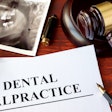
"Malpractice" was the word at two same-day presentations held at the recent ADA show in San Francisco. Both sessions discussed how dentists could arm themselves against patient lawsuits. The best defense? Take good notes.
A complete patient record should include more than just treatment notes, say Curtis Jensen, a Monterey, California dentist, and David J. Weiss, a Los Angeles medical/dental malpractice attorney, who co-presented the "Risk Management" session. "Your practice hinges on your records. They're legal documents, evidence, and your best defense in a lawsuit."
One sixth of the medical malpractice lawsuits in the U.S. are filed against dentists (it's one third in California), according to Mitchell Gardiner, a dentist in Fair Haven, New Jersey, who reviews malpractice lawsuits as an expert witness and hosted the ADA session on "Malpractice and Documentation." "You think you charge a lot for a crown? Wait till you see the legal fees associated with a case."
A typical lawsuit
To illustrate how bad note taking can come back to haunt dentists, the seminars presented real lawsuits. Consider the California case of Reese v. Mallory. Reese had been a patient of Dr. Mallory since 1980, but continually declined X-rays and periodontal probing due to cost concerns. By 2003, she had only 21 teeth remaining. The following year, Reese complained of pain in tooth #21. Mallory found nine-millimeter pockets and suggested extraction. He also referred Reese to a periodontist, who took radiographs and was shocked to see seven 9-mm. pockets throughout Reese's mouth. Her lower teeth couldn't be saved. The periodontist called Mallory, who was surprised but explained Reese's X-ray refusals.
Meanwhile, a frantic Reese searched the yellow pages for a prosthodontist, who suggested she sue her dentist. Reese sought $150,000 in compensatory damages, alleging Mallory neglected to treat her periodontal disease over a 20-year span.
When the attorneys asked for Mallory's patient record, all he had to show was one page, scrawled in nearly illegible pencil, lacking any detail on appointments spanning over 20 years. He had referred her to a periodontist 14 times, but never noted that on the chart.
"Mallory did very little to prepare himself, despite lots of warning signs," says Weiss. "Patients who consistently refuse X-rays or referrals are the ones who are going to trap you."
The result? Mallory settled the case for a six-figure sum.
Record this
Every patient record should include:
- All radiographs, lab forms and models, plus a summary of what you learned from them
- A complete description of the dental treatment performed
- How that treatment will address problems identified in your diagnosis
- If your diagnosis leads to more than one treatment alternative, note them all
- Any reasons for choosing an uncommon alternative
- Whether all or part of the treatment requires a referral to a specialist, and who you recommended
"The most accurate records are those you take down while seeing the patient," says Gardiner. "Patient complaints and discussions are easy to forget later on."
Even if your patient signs a waiver, you're still at risk, says Weiss. "If you lay an instrument on a patient and you see suspicious signs, you should know better than to do nothing."
Jensen requires his patients to sign an informed refusal form, and educates them on the consequences of rejecting treatment. He also follows up with a separate letter. "When my patient refuses X-rays, I tell him that if he does not get radiographs within two weeks, he must find another dentist. I document it in the record." If the patient leaves, says Jensen, he sends them a letter and notes their exit from his practice. "Good riddance," says Jensen. "The stress is gone."
But a referral doesn't get you off the hook. If that specialist screws up, the patient will often sue both of you. "Know who you are referring to," says Jensen. "Your colleagues are an extension of your practice." The more serious the referral, the more you must follow up on outcomes. Don't just give the patient a verbal referral. To protect yourself, schedule that referral appointment from your office before the patient leaves.
It is acceptable to make changes in your records, says Gardiner, but you must date the new info, relate it to the previous entry, and explain the change. If you made an error, cross it out and label it as "error." Don't make any subjective comments about the patient on the chart – keep a separate diary sheet in the folder so it won't be involved in the lawsuit. Financial records should also be kept separate.
Health histories are vital
It's recommended that you now take patients' vital signs (blood pressure and pulse) at every visit and pay attention to external indicators, such as clammy skin, shortness of breath, and the patient's comments about their well-being. If the signs look bad, consider not treating them and/or referring them to a physician for a checkup.
Failure to do so and the consequences are illustrated in the case of Larson v. Andrew. The 53-year-old obese Larson checked "no" to all health history questions every year. During a tooth extraction, Larson had heavy breathing and clammy skin and despite documenting it, Andrew said nothing and went on with treatment. He requested Larson get a follow-up call after the appointment but the staff forgot. As they all left for the day, they saw Larson slumped over in his car, dead for several hours. His wife sued for $750,000 in compensatory damages and future earnings (Larson earned good money), alleging Andrew's failure to review Larson's health, resulting in his death. The jury found Andrew negligent for not voicing concerns. Although Andrew did not have to pay damages, his reputation took a beating.
Bottom line: Update your patient's health history at every appointment (skip the two weeks for crowns and bridges). Your patient should sign it and you should initial it to show you looked it over. If an answer doesn't jibe with what you've observed in your patient, inquire verbally and note the patient's responses in the record.
Protect yourself
Check your state's Dental Practice Act for dental recordkeeping requirements. All three presenters stressed that you must never throw records away. That's because in most states, the statute of limitations is two years from the time the incident occurs or when the patient discovers it, which could be 20 years after treatment.
Digital records are an ideal way for documenting patient history. You eliminate illegible handwriting and make diagnosis and treatment easier for you and your patient to follow. Electronic records are easier to transfer and take up far less space than their paper kin.
So when your next patient comes in, open your ears, uncap a pen and start taking notes. Minor hand cramps and inky fingers are a minor price to pay for avoiding thousands in legal fees, or worse, a huge judgment. "No matter how much time you spend caring for your patients, if you don't note it in your records, it won't make a difference to a jury of 12 non-dentists," says Gardiner.



















